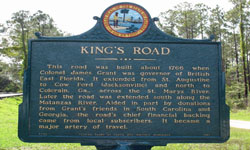|
|
Flagler Beach
was home to the Timucuan Indians long before Europeans arrived in Florida. From information obtained from the Timucuans, itís estimated that around 14,000 Indians lived in the area that is now Flagler Beach from about 10,000 B.C. to the mid 1500s. Spanish explorers arrived in the area in 1567. French explorers were already in the area that is now Jacksonville, Florida. Hostilities between the Indians and the Spanish, French and English escalated. One result was the Matanzas massacre on the beach in what is now northern Flagler County. The inlet south of Anastasia Island is now called Matanzas. The wars destroyed most of the artifacts of the Timucuan Indian civilization and the tribe itself was eventually destroyed due to their lack of immunity to Spanish diseases.
 In 1766, the British built the Kingís Road from the state of Georgia to Jacksonville, Florida, through Flagler Beach and on to New Smyrna. Bridges were constructed over Pellicer Creek and the Tomoka River. This British-built road is still a main highway through Flagler County. One of the earliest settlers in the area was Josia Dupont, who received a tract of land from the Spanish King. He didnít remain in Flagler Beach, but his son, Abraham Depont arrived in the area with his family in 1825 and became one of the first residents. Other early pioneers in the Flagler Beach region were James Russell, James Ormond I and Charles Bulow, who built the first working plantation in the area. In 1766, the British built the Kingís Road from the state of Georgia to Jacksonville, Florida, through Flagler Beach and on to New Smyrna. Bridges were constructed over Pellicer Creek and the Tomoka River. This British-built road is still a main highway through Flagler County. One of the earliest settlers in the area was Josia Dupont, who received a tract of land from the Spanish King. He didnít remain in Flagler Beach, but his son, Abraham Depont arrived in the area with his family in 1825 and became one of the first residents. Other early pioneers in the Flagler Beach region were James Russell, James Ormond I and Charles Bulow, who built the first working plantation in the area.
 Following the Civil War, the local economy received a huge boost when the Mala Compra Plantation changed from making sugar to boiling sea water to make salt. Slowly, the Flagler Beach area began to attract people who came to the area for recreation and pleasure, such as millionaire industrialist, Henry Cutting and his wife, Angela, who built a vacation lodge in Flagler in 1866. Their estate still stands today. In 1881 an inland water route was created between Jacksonville and New Smyrna by constructing a canal connecting the Matanzas and Halifax Rivers. This would eventually be extended and become known as the Intracoastal Waterway. Next came the railroad and the many industries it helped to create. In 1885, Henry Flagler bought the narrow gauge railroad that served the area and converted it to standard gauge. This increased access to Flagler for cattle, timber, potato and citrus producers to the interior. Flagler was so influential to the region that when Flagler County was formed in 1917, it was named for him. The county contained the communities known as Bunnell, Espanola, St. Johns Park, Haw Creek, Dupont, Korona and Ocean City which is now known as Flagler Beach. The city of Flagler Beach was incorporated in 1925. Following the Civil War, the local economy received a huge boost when the Mala Compra Plantation changed from making sugar to boiling sea water to make salt. Slowly, the Flagler Beach area began to attract people who came to the area for recreation and pleasure, such as millionaire industrialist, Henry Cutting and his wife, Angela, who built a vacation lodge in Flagler in 1866. Their estate still stands today. In 1881 an inland water route was created between Jacksonville and New Smyrna by constructing a canal connecting the Matanzas and Halifax Rivers. This would eventually be extended and become known as the Intracoastal Waterway. Next came the railroad and the many industries it helped to create. In 1885, Henry Flagler bought the narrow gauge railroad that served the area and converted it to standard gauge. This increased access to Flagler for cattle, timber, potato and citrus producers to the interior. Flagler was so influential to the region that when Flagler County was formed in 1917, it was named for him. The county contained the communities known as Bunnell, Espanola, St. Johns Park, Haw Creek, Dupont, Korona and Ocean City which is now known as Flagler Beach. The city of Flagler Beach was incorporated in 1925.
|
|
|